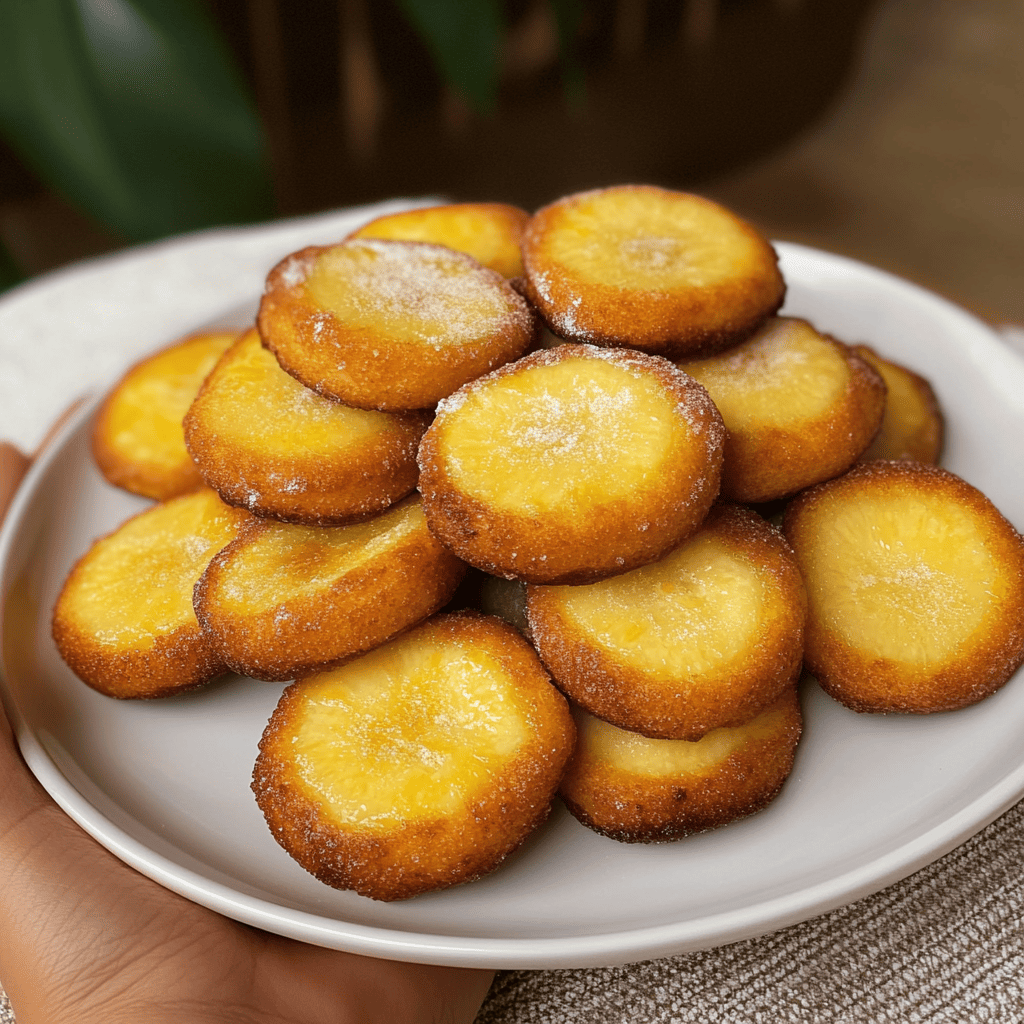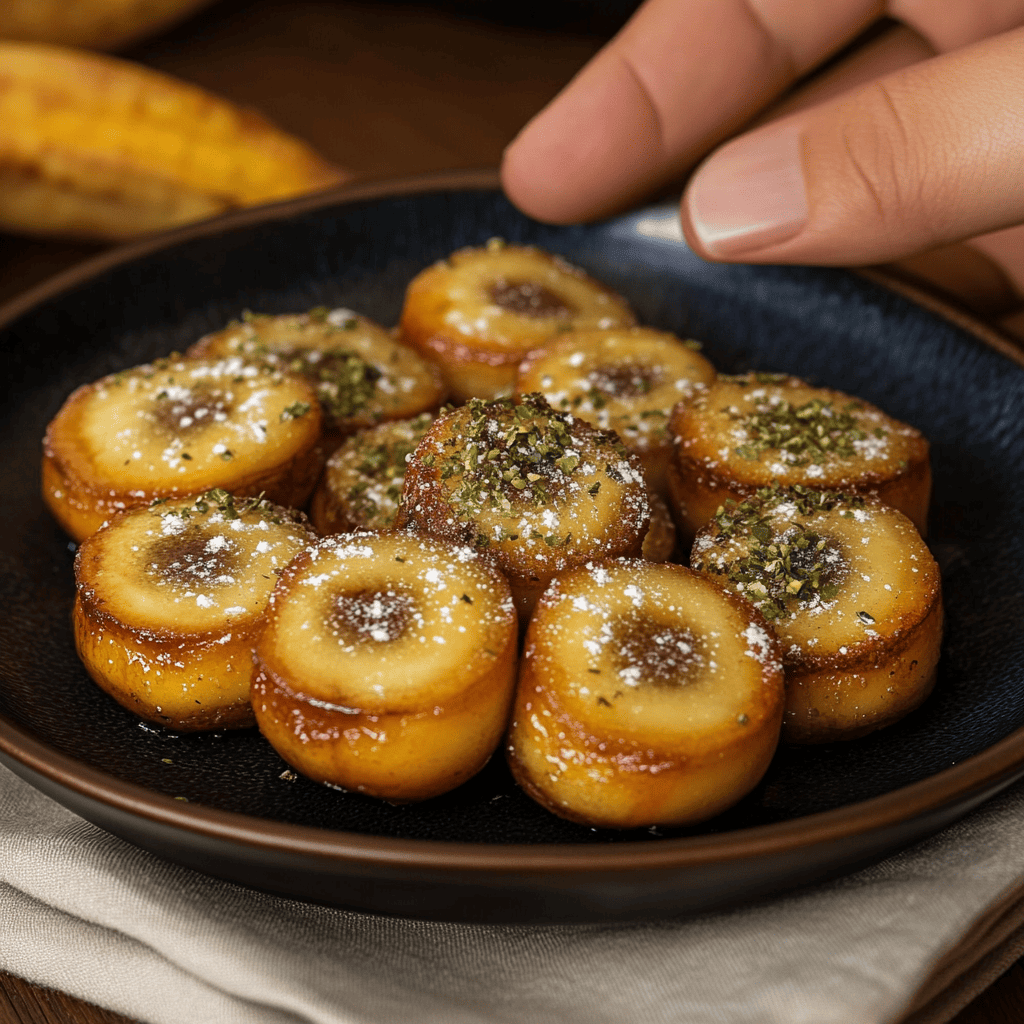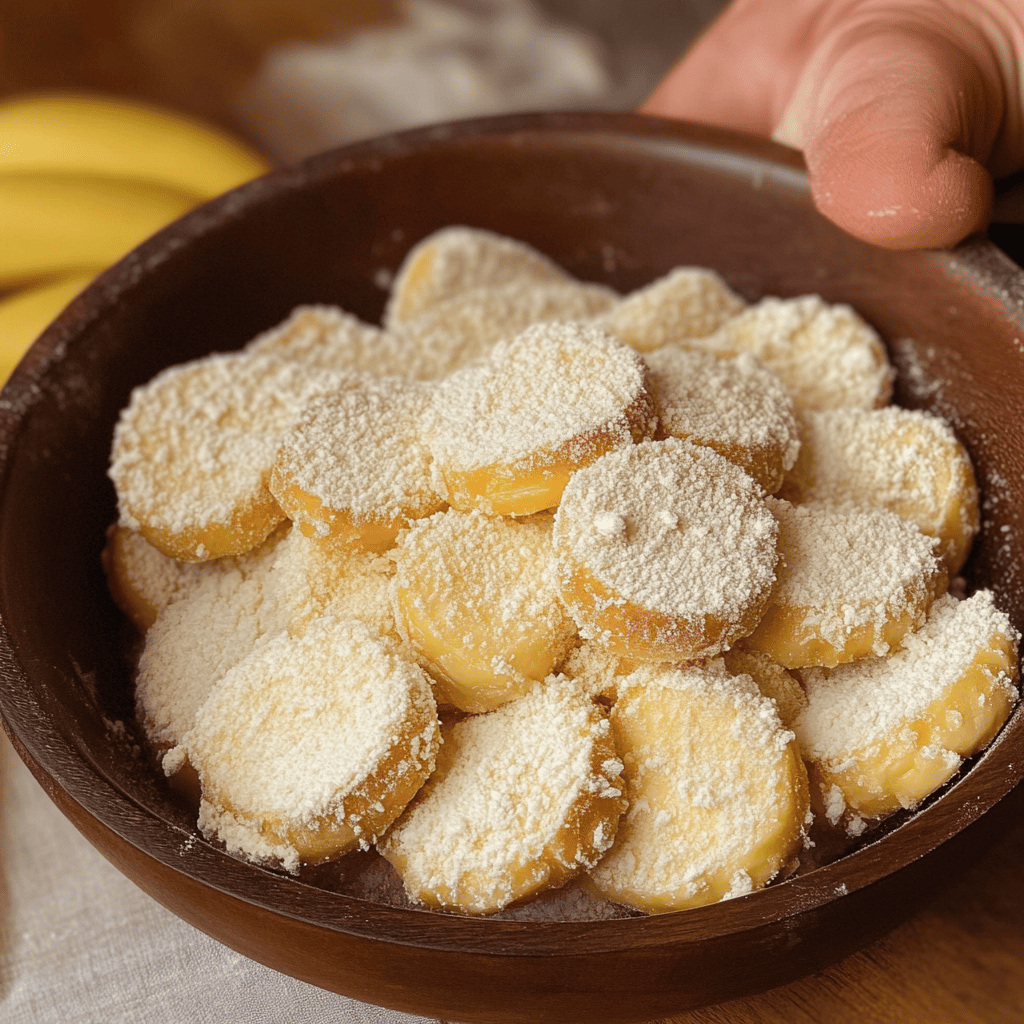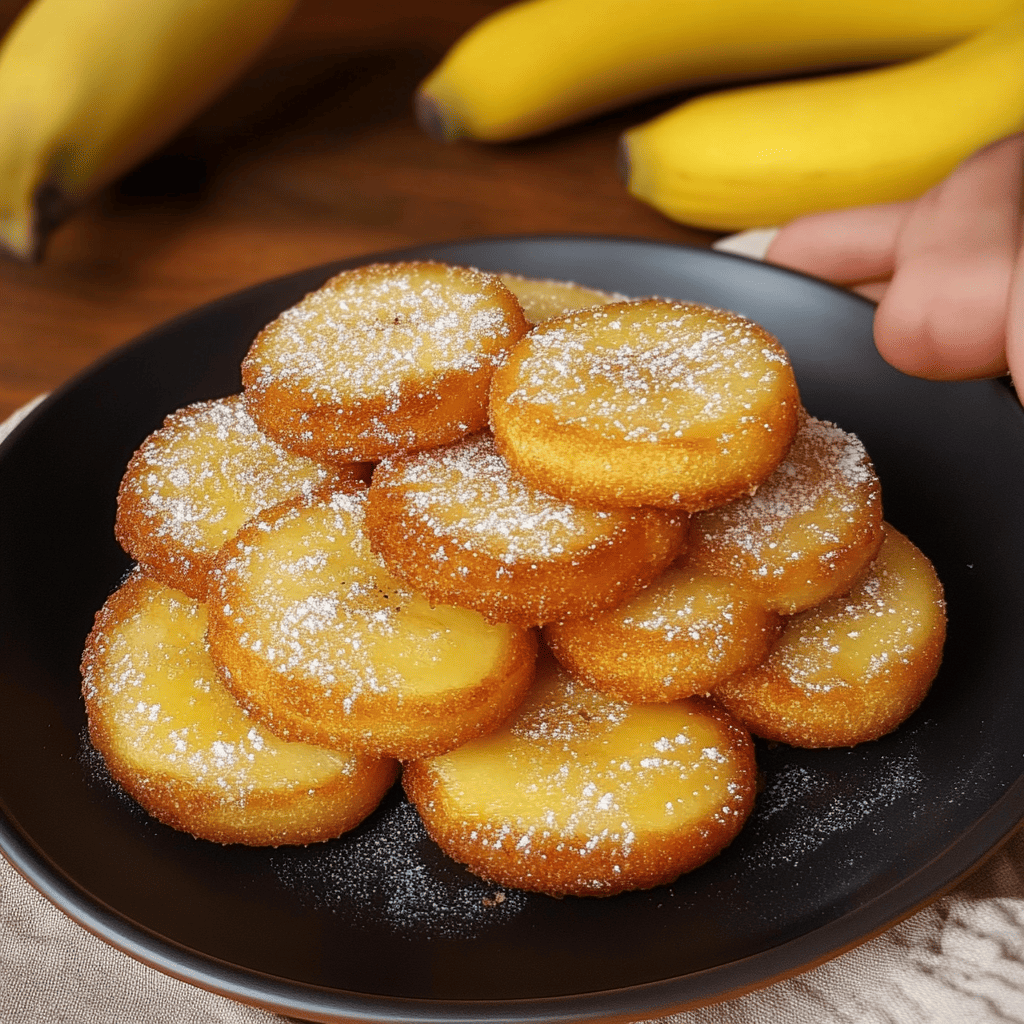Banana Medallions: A Sweet, Golden, and Crunchy Treasure
Introduction: A Revisited Classic with a Taste of Home
“Banana Medallions,” as seen in the image, are a delicious reinterpretation of a traditional dessert or snack, combining the natural sweetness of bananas with a crunchy, sugary coating. This dish, which evokes the warmth of home cooking, is surprisingly simple to prepare and offers an unparalleled taste and texture experience. Each medallion is a golden jewel, with a tender banana interior and a lightly caramelized exterior dusted with sugar and cinnamon. They’re perfect to share at any time of day, from breakfast to dessert, or simply as a sweet treat. Discover all the secrets of this preparation, which you’ll love for its simplicity and delicious results!
Detailed History in Spanish: From the Tropics to the Global Plate
The history of “Plain Medallions” is intrinsically linked to the history of the plantain itself and its role in diverse culinary cultures, especially those with traditions of fried foods and sweet desserts. Although the specific recipe using yeast dough and fried plantain is less ancient than that of the plantain, it represents an evolution of homemade preparations.
The Plantain: A Fruit with Ancient Roots: The plantain (or banana, depending on the region) is one of the oldest cultivated fruits in the world, originating in Southeast Asia (Papua New Guinea) thousands of years ago. It spread throughout Africa and, with the arrival of Portuguese and Spanish explorers, was introduced to America in the 16th century. In tropical and subtropical regions, the plantain became a staple food, eaten fresh, cooked, fried, or roasted.
Fried Food in Gastronomy: The technique of frying foods dates back to ancient civilizations in Egypt and Mesopotamia. In many cultures, frying has been used to create crispy textures and enhance flavors, especially in sweets and desserts. In Latin America, Africa, and Asia, where plantains are abundant, there are countless variations of fried plantains, from plantain slices to fritters and pancakes.
Buñuelos and Fried Yeast-Based Doughs: The idea of wrapping fruit in batter and frying it is a concept found in many cuisines. Buñuelos, for example, are popular in Spain and Latin America and are typically fried dough pieces, sometimes with fruit inside, and sprinkled with sugar. The batter used in Banana Medallions, with yeast and egg, resembles a fritter or doughnut batter, suggesting an influence from these traditions.
The “Medallion” or “Slice” Shape: Slicing the plantain before coating and frying it is a practical way to ensure even cooking and create individual servings. This “medallion” presentation is aesthetically pleasing and easy to handle, making it ideal for desserts or snacks.
The Cinnamon and Sugar Combination: Cinnamon is a spice with a long history, originating in Asia. Its aromatic sweetness and warmth make it a natural companion for bananas and fried desserts. The combination of sugar and cinnamon is a classic finish that adds an extra layer of flavor and a crunchy texture to fried treats.
The Evolution Toward Convenient Homemade Desserts: In the home kitchen, the need for delicious yet relatively easy-to-prepare desserts has led to the development of recipes like these Banana Medallions. Using basic pantry ingredients (flour, sugar, eggs, milk) and bananas, you can create a stunning dessert with moderate effort. The image suggests a homemade, artisanal result.
In short, “Banana Medallions” are the result of a fusion of the ubiquitous presence of the banana in many cultures, the tradition of frying as a cooking method, and the art of creating comforting homemade desserts. It’s a dish that celebrates the natural sweetness of the fruit and transforms it into an indulgent and memorable experience.
More Historical Detail: Sweet Gastronomy and Indulgent Texture
Delving a little deeper into the history and cultural significance of the “Banana Medallions,” we can highlight:
- The Banana as a Versatile Element in Baking: In many cultures where bananas are abundant, they are not only consumed fresh but are also incorporated into a wide variety of desserts, from banana breads to cakes, ice cream, flans, and fried foods. The versatility of the banana, especially when ripe, is a cornerstone of tropical baking. Its natural sweetness allows for a reduction in the amount of added sugar in some preparations.
- Yeast and Airy Texture: The use of dried yeast in the batter is crucial to the texture of these medallions. Unlike a simple flour and water batter, the yeast produces carbon dioxide during fermentation, creating a light and airy batter that expands when fried. This results in a “buñuelo” or “doughnut” that is soft on the inside and crispy on the outside, elevating the fried plantain experience.
- Influenced by Street and Fair Sweet Traditions: Many fried sweets like these medallions have their roots in street or fair food traditions. They’re easy to make in large batches, portable, and universally appealing for their sweetness and texture. This homemade recipe is a reflection of that accessible indulgence.
- The Role of Frying Oil: The choice of oil and the proper temperature are critical to the success of these medallions. A neutral vegetable oil at the correct temperature ensures even browning without burning the exterior and thorough cooking of the interior. Too low a temperature would result in a fatty medallion, and too high a temperature would result in one that is burnt on the outside and raw on the inside.
- Sugar and Cinnamon: A Dynamic Duo: The combination of sugar and cinnamon to coat fried sweets is a classic in many parts of the world (think churros or donuts). Cinnamon not only provides a warm, sweet aroma that perfectly complements the banana, but it can also help cut through the richness of the fried food with its slightly spicy note.
These medallions are a testament to how home cooking, with humble ingredients and time-honored techniques, can create desserts that are not only delicious but also have a deep cultural resonance and evoke memories of sweetness and comfort.

Ingredients & Detailed Preparation
Ingredients:
- Wheat flour: 210 g
- Sugar (for the dough): 1 tablespoon
- Active dry yeast: 5 g (approximately 1 ½ teaspoons)
- Large egg: 1 unit
- Oil (for the dough): 3 tablespoons
- Warm milk (approximately 37-40°C): 80 ml
- Salt: ½ teaspoon
- Ripe bananas (but firm, not too soft): 6 units
- Vegetable oil (for frying): Enough for about 5-7 cm depth in your pot or pan
- Sugar (for coating): 1 cup (200 g)
- Cinnamon powder: To taste (½ – 1 teaspoon, or more if you like it)
Necessary equipment:
- Large mixing bowl
- Hand or stand mixer (optional)
- Cling film or kitchen cloth
- Sharp knife
- Deep pot or pan for frying
- Cooking thermometer (optional, but recommended for frying)
- Skimmer or tongs for frying
- Absorbent paper or cooling rack
- Deep plate for the sugar and cinnamon mixture
Detailed Preparation:
A. Prepare the Fermented Dough:
- Activate the yeast: In a small bowl, combine the warm milk with the tablespoon of sugar from the dough and the dried yeast. Stir gently and let it sit for 5-10 minutes, until the mixture becomes foamy. This indicates the yeast is active.
- Mix dry ingredients: In a large bowl, combine the wheat flour and salt. Make a well in the center.
- Combine wet ingredients: In a separate bowl, lightly beat the egg and 3 tablespoons of oil.
- Combine the dough: Pour the activated yeast mixture and the egg and oil mixture into the well of the dry ingredients. Mix with a wooden spoon or spatula until a sticky dough forms.
- Knead: Transfer the dough to a lightly floured surface. Knead for 5-7 minutes, or until the dough is smooth and elastic. If you have a stand mixer with a dough hook, knead on medium-low speed for about 5 minutes. The dough should be slightly sticky, but manageable.
- First rise: Place the dough in a lightly greased bowl, turning it to coat it with oil. Cover the bowl with plastic wrap or a damp kitchen towel and let it rise in a warm place for 1 to 1.5 hours, or until it doubles in size.
B. Prepare the Plantains and Fry:
- Prepare the sugar and cinnamon mixture: In a bowl, combine the cup of sugar with the ground cinnamon. Mix well and set aside.
- Prepare the plantains: While the dough is rising or just before frying, peel the plantains. Cut them into slices approximately 1.5-2 cm thick. Try to make all the slices of a similar thickness for even cooking.
- Heat the oil: In a deep, heavy-sided pot or skillet, pour enough vegetable oil to reach a depth of about 5-7 cm. Heat the oil over medium-high heat until it reaches 170-175°C (340-350°F). If you don’t have a thermometer, you can test it with a small piece of dough; it should bubble immediately when dropped into the oil.
- Coating the plantains: Once the dough has risen, gently deflate it and knead it lightly again on a floured surface. Roll out the dough until it’s about 3-4 mm thick. Using a cookie cutter or a glass (slightly larger in diameter than the plantain slices), cut out circles of dough.
- Breading process: Take a slice of plantain and place it in the center of a circle of dough. Close the edges of the dough around the plantain, pinching them tightly to completely seal the plantain inside the dough, forming a kind of ball or dumpling. Make sure there are no gaps to prevent the plantain from escaping or oil from getting in.
- Fry the medallions: Carefully slide 3-4 plantain medallions into the hot oil (don’t overcrowd the pan to prevent the oil from dropping). Fry for 2-3 minutes on each side, or until evenly browned and the batter is cooked through.
- Drain and coat: Using a slotted spoon, remove the fried medallions from the oil and place them on paper towels to remove excess fat. Immediately, while still warm, toss them in the sugar and cinnamon mixture, making sure they are well coated on all sides, as shown in the picture.
C. Serve:
- Plating: Place the coated plantain medallions on a serving plate.
- Enjoy: Serve hot.
Estimated Preparation Time
- Active preparation (mixing dough, cutting bananas, coating): 25-30 minutes
- Dough rising time: 1 – 1.5 hours
- Frying time: 15-20 minutes (in batches)
- Total time: Approximately 1 hour 40 minutes to 2 hours 10 minutes (including rising).
Additional Tips
- Ripe but firm plantains: It’s crucial to use plantains that are ripe (with some black spots on the skin), as they will be sweeter, but still retain some firmness so they don’t fall apart when handled and fried.
- Oil Temperature: Maintaining a constant oil temperature is key to successful frying. A cooking thermometer is very helpful. If the oil is too cold, the medallions will absorb too much fat; if it’s too hot, they’ll burn on the outside before cooking through.
- Don’t overcrowd the pan: Frying in small batches helps maintain the oil temperature and helps the medallions brown evenly.
- Dough variations: If you want a quicker yeast-free option, you can use a yeast-free fritter dough, which usually contains flour, egg, milk, and a little baking powder, but the texture will be different.
- Other toppings: Instead of sugar and cinnamon, you can drizzle with honey, maple syrup, melted chocolate, or powdered sugar.
- Dough Storage: The dough can be prepared in advance and stored in the refrigerator overnight to allow it to rise slowly. Remove it from the refrigerator an hour before use to allow it to return to room temperature.

Frequently Asked Questions
- Can I use green plantains? No, this recipe calls for ripe (but firm) plantains because their sweetness intensifies as they ripen, and their texture becomes more tender, ideal for this recipe.
- Can you bake them instead of frying them? Yes, you can bake them, but the texture will be different (less crispy and more like a soft bread roll). If you bake them, brush them with a little oil and bake at 190°C (375°F) until golden brown, turning them over halfway through.
- What should I do if the dough doesn’t rise? Make sure the yeast is active (dissolve it in warm water with a little sugar and wait for it to bubble). Also, make sure the milk isn’t too hot (it would kill the yeast) and that the environment is warm enough for rising.
- How long do they last? These medallions are best enjoyed freshly made and warm. They can be stored at room temperature in an airtight container for 1-2 days, but they will lose their crispness.
Texture and Flavor
The texture of the Plantain Medallions is sublime: the exterior of the fried dough is slightly crispy and golden, with a layer of sugar and cinnamon adding a delicate crunch. Inside, the dough is soft and fluffy, a kind of tender fritter. The plantain core is smooth and almost creamy, warmed by frying, contrasting with the texture of the dough.
The flavor is a sweet and aromatic explosion. The ripe plantain contributes its natural, fruity sweetness, which is intensified by the heat. The fried dough has a mild, slightly sweet flavor, and the combination of sugar and cinnamon on the outside adds a layer of spicy, caramelized flavor. It’s a comforting, indulgent dessert that satisfies your sweet tooth without being overly heavy.
Consumer Context
Banana Medallions are ideal for:
- Dessert: Perfect after a meal.
- Snack: A sweet treat for any time of day.
- Breakfast or brunch: Accompanied by coffee or tea.
- Celebrations or gatherings: They are easy to make in large quantities and everyone loves them.
- Homemade gift: A sweet touch for friends and family.
Visual Aspect
The dish is visually very appealing and appetizing, as can be seen in the image. The plantain medallions are uniformly round and have a beautiful deep golden color, indicative of perfect frying. The surface is generously sprinkled with sugar crystals (and cinnamon), which glisten and add a tempting texture. In the center of each medallion, the plantain slice can be seen, displaying the fruit’s characteristic star, making them even more special and recognizable. The presentation on a rustic plate and the fact that they are held in the hand enhance their homemade and appetizing appearance, inviting you to try them immediately.
Curiosities
- Plátano vs. Banana: Although often used interchangeably, “plátano” in many Spanish-speaking countries refers to the cooking fruit (plantain), while “banana” refers to the sweet dessert plantain. This recipe uses the sweet plantain, which is sometimes called “banana.”
- Benefits of bananas: Bananas are an excellent source of potassium, fiber, and vitamins B6 and C, making them a sweet treat with a nutritious touch.
- Dough Variety: Batters for frying fruit vary widely around the world. Some use pancake batter, others churro batter, and some are just flour and water. This recipe uses a yeast-based batter, which gives it a softer, more bready texture.
Nutritional Value (Estimated per Serving)
Since this is a fried dessert and portions may vary, the values are rough estimates. Let’s assume 1-2 medallions per serving.
- Calories: 200-350 kcal per medallion (depending on size and oil absorption)
- Carbohydrates: 30-50 g (mainly from flour, sugar and banana)
- Sugars: 15-30 g
- Fat: 8-15 g (from dough oil and frying oil)
- Saturated fat: 1-3 g
- Protein: 3-5 g (from flour and egg)
- Fiber: 2-4 g (from banana)
- Vitamins and minerals: Potassium (from banana), some B vitamins.
Additional Benefits and Interesting Facts
- Energy source: The carbohydrates in the banana and flour provide quick energy.
- Sweet Satisfaction: A delicious way to satisfy your sweet tooth.
- Versatility of presentation: They can be served alone, with ice cream, whipped cream, or fresh fruit.
Other Information
- Storage: Ideally, Plantain Medallions should be consumed immediately after preparation to enjoy their optimal texture and flavor. If you have leftovers, store them in an airtight container at room temperature for a day. To reheat, an air fryer or a low-temperature oven can help restore some of the crispiness.
- Pairing: They combine perfectly with a cup of coffee, an aromatic tea, or a glass of cold milk.

Conclusion: A Golden Bite of Homemade Happiness
“Banana Medallions” are much more than a simple dessert; they are a taste of homemade joy, a testament to how simplicity can lead to culinary delight. The combination of tender, sweet banana, airy, fried dough, and the aromatic touch of sugar and cinnamon creates an unforgettable experience. They are a reminder that the most comforting desserts often come from the simplest recipes. Go ahead and make them and share the joy of these golden medallions!

